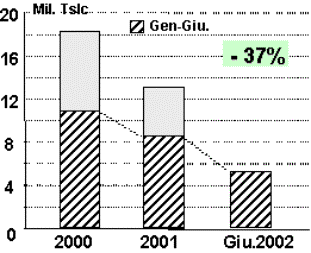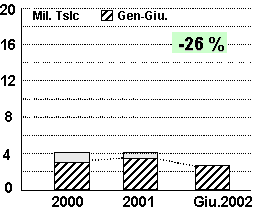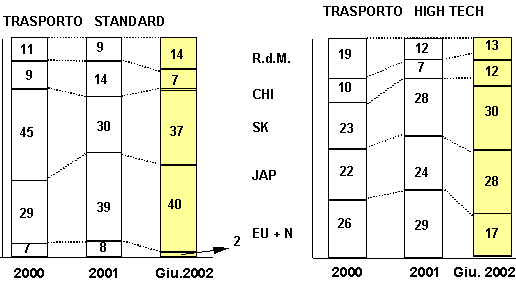|
|
|
by D. Cazzaniga Francesetti ECONOMICAL SITUATION OF THE SHIPBUILDING INDUSTRY AND SAFETY
This part describes the international, national, Tuscan and Livornese situations of shipyards that produce commercial vessels and leisure boats, indicating the relationship between safety and the growth/decline in that relevant sector. Statistics quoted relate to injuries, professional illness and deaths in Tuscany and the province of Livorno. This is followed by a description of a general manufacturing cycle including those characteristic of the commercial and leisure boat-building sector, emphasising where all the greatest risks can be found. We would indicate below the most relevant internet sites: 1- all the national and European legislation relating to prevention and safety at work can be found at the Ispesl site (www.ispesl.it). 2-the statistics can be found on the Inail (www.inail.it) and USL6 Livorno (www.usl6.toscana.it) sites. 3-certain aspects of general safety and of shipyard safety in particular are not directly linked to legislation, but to the IMO and ILO agreements, as is voluntary ecological and quality certification. 1.1 International factors which influence commercial ship production In
order to put the problems of commercial shipyards in context,
it is necessary to see the problem from an international point
of view. In other words, demand for new vessels depends not on
national but on international factors, among which the most important
are:
In the years 2000 and 2001 GNP in the OCSE area grew by around 3% and international trade by about 8%, therefore compensating for the poor performance in 1999 due to the Asian crisis. However, due to a general slowdown, the GNP of the OCSE countries grew less than 3% in 2002. This was in line with figures for the rest of the world. In the current year there has been a consequent fall in the request for vessels. New orders for ships in the period 2000-1 reached an all-time high, with an increase of more than a third on 1999, which itself had seen a high level of demand. The reason for this boom, which largely consisted of an anticipation of the demand to follow in the next few years, was primarily due to the low price of ships offered chiefly by Asian shipyards. The distortion of competition, which developed mainly between European and Korean shipyards, was largely due to a sharp drop in the value of the Korean Won against other currencies. Competition between Chinese shipyards and Korean ones due to lower work costs led to a further drop in prices in 2002. If prices were to continue to remain low, this could encourage ship-owners to place new orders notwithstanding the drop in charters, causing a further slowdown in shipbuilding worldwide and the oversupply of vessels in almost all sectors. The table below shows orders at international level divided by area. AWES (the Association of West European Shipbuilders) is the source of the figures on sector activity at international level updated to 30.6.2002 and based on Lloyds' Register - Fairplay data. (Tab.n.1) Tab.n. 1 Manufacturing areas. First six months 2002 figures
Source: AWES 2002
The following table shows comparative figures for 2000, 2001 and the first half of 2002. It can be seen ( Tab. no. 2) that during the first six months of the year new orders for goods carrier vessels amounted to 8.2 million tslc, as against 12.4 million tslc for the same period of 2001, representing a drop of 34%. Tav.n.2 All orders for goods carrier vessels in 2000, 2001 and the first 6 months of 2002
Source: AWES 2002 The two sectors of standard transport and high-tech transport both show significant drops in orders in the current year. This is particularly marked after the boom of 2000, when orders were up 39% on 1999. There could be an increase in orders in the second half of 2002 due to low prices at the shipyards, although there is an oversupply of all types of ships in comparison with world goods sea-traffic. The figures indicate (Tab.n.3a and b) that for standard transport (tankers, general cargo, containers, product, bulk carriers) demand is at 5.7 million tslc, a drop of 37% on the first half of 2001. This drop is reflected in all vessel types with the exception of bulk carriers, which are up 20%. For high-tech transport (ro-ro vessels, ferries, LPG; LNG, chemicals and others) orders are at around 2.8 million tslc, a drop of 26% on the first half of 2001. Tab.n.4 shows how orders for standard and high-tech vessels are divided in different parts of the world. Tab. no. 3a Orders for standard vessels January-June in the three-year period
(Source. AWES 2002)
Tab. no. 3b World-wide orders for high-tech vessels January-June in the three-year period
(Source: AWES 2002)
Tab. no. 4 Distribution of orders between different manufacturing areas worldwide as percentage
(Source:
AWES 2002) Even if orders were to increase in the second half of 2002 two conclusions are incontrovertible: 1- Orders for new ships are decreasing; and 2- European shipyards are not only being marginalized in relation to standard production, but are also losing out in high-tech production, with even top sector cruise ships at risk. With regard to this latter sector, some comment needs to be made on the ferry sector. Demand for ferries is still decreasing (down 23% on the first six months of 2001). 23 "large ferries" (over 150 metres) were in construction as of 30 June 2002, for around 587,000 tslc, worth 1.58 billion dollars. Italian shipyards have a 28% share in the ferry sector. As of 30 July 2002, the work in progress for cruise ships over 20,000 tslc involves 32 vessels for 3.7 million tslc, worth 12.8 billion dollars (Tab. no. 5). Italian shipyards, including Fincantieri and Mariotti, have 43.9% of world-wide orders. This is currently the most promising sector for orders for Italian shipyards. Tab. no. 5 Orders for cruise ships in shipyards worldwide in 2002
Source: Assonave. Sept. 2002 To summarise, on the assumption that the first six months of 2002 reflect the general performance in the sector, it can be seen that; Far East shipyards hold 84% of orders for standard transport and 70% of orders for high-tech transport; Korean and Japanese shipyards have increased their presence in both sectors; Chinese shipyards hold 12% of high-tech demand; 47% of demand for new constructions comes from Europe, more than half of which (55%) goes to Korean shipyards and only 13% to Europe. Orders from European ship owners make up more than three-quarters of orders received by Korean manufacturers; European shipyards are marginalized in the standard sector and have suffered significant downsizing in the high-tech sector (-12%) which is largely made up of ferries and cruise ships. This all bodes for an increasingly difficult future for European and Italian shipyards.
Vessels ordered from Italian shipyards (Tab. No. 6) are mainly passenger ships, that is cruise ships and ferries, as well as special ships for petroleum derivatives, product carriers and ro/ros for transporting vehicles. It should be noted that there are no new orders for standard ships such as full containers, bulk carriers for dry products and tankers. Tab. no. 6 Order books for Italian shipyards. Order books as at 30.06.02
Source: Assonave 2002 Tab.
no. 7 shows vessels in construction in Italian shipyards. Tab. no.7 Vessels under construction in Italian shipyards as at 30.06.2002
Source : Assonave 2002. Ten ships were completed in the first half of 2002 for 328,325 tslc, worth 940 million Euro of which 782 million Euro was for overseas companies. The order book is sufficiently well covered only up to next year (see tab. no.9). The value of the order book of 48 vessels, 46 of which are to be delivered by 2004, is 5,873 million Euro, 3,808 million of which is for overseas companies. Tab. no.8 Delivery forecast up to 2004 and beyond
*including 10 already delivered Source : Assonave 2002.
1.4 Tuscan shipyards for the construction of commercial vessels The following shipyards for the construction of commercial vessels are based in Tuscany: The Fratelli Orlando shipyard - CNFO-Livorno- This company was founded in its present cooperative company form in 1995, when it took over the property of the almost century-old shipyard, and is currently under temporary receivership. The shipyard personnel has accumulated know-how and experience matured also under Fincantirei ownership. The severe competition world-wide has forced the shipyard to expand into the highest segment of the market and it has received orders in this segment specifically on the merit of its reputation. The shipyard could have garnered success if financial difficulties had not slowed production of ships on order. CNFO had always honoured assumed commitments previously. Orlando and companies related to it employed more than 1,000 people until recently. As in all shipyards the world over it is difficult to control the workforce of related companies, especially in matters of safety. 80% of work carried out is awarded to subcontractors. Internal operators are often given the job of supervising and checking that external firms carry out their work within the time and in the manner required. It is at least possible to check whether illegal workers are being used when work is carried out in the shipyard. Three people have died in the shipyard in recent years, but these deaths can be attributed to true accidents, and not to a lack of safety regulation awareness. The climate of insecurity at the shipyard induced by the financial difficulties may have caused a relaxation in the necessary care of individuals. The N.C. Pania shipyard is a public company. The SEC shipyard has recently gone bankrupt. All the vessels built in these shipyards were made of steel. The Orlando shipyard used to build around one and a half ships a year.
The first thing to note is that during the first half of 2002 there was an expected fall in orders both worldwide and in Italy. The large numbers of ships produced in previous years indicated that there would be a foreseeable and substantial reduction in requirements for new ships in subsequent years, as has indeed been the case. A further anticipation of demand could occur only were the low costs of Korean and especially Chinese shipyards to be maintained, and this itself would lead to another sharp drop in orders for the following period. The situation in Italy indicates that the margination of the standard sector is by now total and that orders in the chemical, gas, ferries and cruise ship sector are also being eroded. Only a decisive increase in productivity, quality and technological innovation, and lowering of prices in Italian shipyards could staunch the drop in orders. Only the Apuania shipyard survives in Tuscany. The serious situation of Orlando shipyard could cause a deterioration in the attention paid to safety regulations no longer due to the carelessness of individuals, but to a true relaxation of safety regulations. In general the negative prospects for the sector suggest that safety and prevention is likely to be neglected in favour of reducing working times and lowering costs. Cost reduction is generally achieved, as it is worldwide, by transferring work from shipyards to poorly controlled contractors. Relaxation of safety regulations and an increase in accidents are clear indicators of economic difficulties in the sector.
|
||||||||||||||||||||||||||||||||||||||||||||||||||||||||||||||||||||||||||||||||||||||||||||||||||||||||||||||||||||||||||||||||||||||||||||||||||||||||||||||||||||||||||||||||||||||||||||||||||||||||||||||||||||||||||||||||||||||||||||||||||||||||||||||||||||||||||||||||||||||||||||||||||||||||||||||||||||||||||||||||||||||||||||||||||||||||||||||||||||||||||||||||||||||||||||||||||||||||||||||||||||||||||||||||||||||||||||||||||||||||||||||||||||||||||||||||||||||||||||||||||||||||||||||



